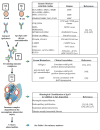Markers for the progression of IgA nephropathy
- PMID: 27142988
- PMCID: PMC5548426
- DOI: 10.1007/s40620-016-0299-0
Markers for the progression of IgA nephropathy
Abstract
We have summarized the latest findings on markers for progression of immunoglobulin A (IgA) nephropathy (IgAN), the most common primary glomerulonephritis with a high prevalence among end-stage renal disease (ESRD) patients. The clinical predictors of renal outcome in IgAN nephropathy, such as proteinuria, hypertension, and decreased estimated glomerular filtration rate (eGFR) at the time of the diagnosis, are well known. The Oxford classification of IgAN identified four types of histological lesions (known as the MEST score) associated with the development of ESRD and/or a 50 % reduction in eGFR. In addition, the role of genetic risk factors associated with IgAN is being elucidated by genome-wide association studies, with multiple risk alleles described. Recently, biomarkers in serum (galactose-deficient IgA1, IgA/IgG autoantibodies against galactose-deficient IgA1, and soluble CD 89-IgA complexes) and urine (soluble transferrin receptor, interleukin-6/epidermal growth factor ratio, fractalkine, laminin G-like 3 peptide, κ light chains, and mannan-binding lectin) have been identified. Some of these biomarkers may represent candidates for the development of noninvasive diagnostic tests, that would be useful for detection of subclinical disease activity, monitoring disease progression, assessment of treatment, and at the same time circumventing the complications associated with renal biopsies. These advances, along with future disease-specific therapy, will be helpful in improving the treatment effectiveness, prognosis, and the quality of life in connection with IgAN.
Keywords: Biomarkers; End-stage renal disease; IgA nephropathy; Renal biopsy.
Conflict of interest statement
The authors declare that they have no conflict of interest.
Figures

References
-
- Wyatt RJ, Julian BA. IgA nephropathy. N Engl J Med. 2013;368:2402–2414. - PubMed
-
- Cattran DC, Coppo R, Cook HT, et al. Working Group of the International IgA Nephropathy Network and the Renal Pathology Society, The Oxford classification of IgA nephropathy: rationale, clinicopathological correlations, and classification. Kidney Int. 2009;76:534–545. - PubMed
-
- Coppo R, Troyanov S, Camilla R, et al. Working Group of the International IgA Nephropathy Network and the Renal Pathology Society, The Oxford IgA nephropathy clinicopathological classification is valid for children as well as adults. Kidney Int. 2010;77:921–927. - PubMed
-
- Feehally J, Floege J. IgA nephropathy and Henoch-Schönlein nephritis. In: Feehally J, Floege J, Johnson RJ, editors. Comprehensive clinical nephrology. 3. Mosby; 2007. pp. 253–264.
Publication types
MeSH terms
Substances
Grants and funding
LinkOut - more resources
Full Text Sources
Other Literature Sources
Medical
Research Materials
Miscellaneous

